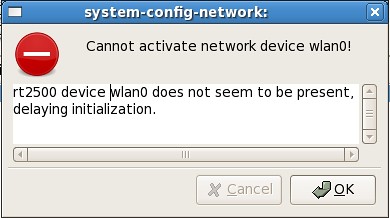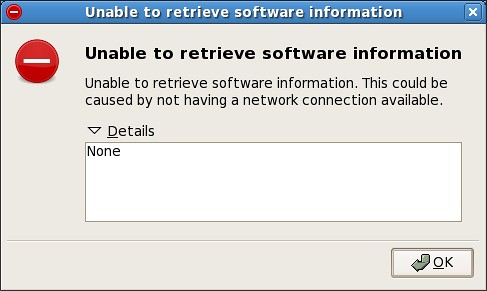More On Fedora 7: Wireless Woes and Second Opinions
Tuesday, June 12, 2007
After my second day using Fedora 7, I believe that enough of my opinions have changed to warrant a second post about the distro. Lets jump right in:
Wireless Woes:
Still no wireless Internet. This is becoming a rather vexing problem, as I have yet to find a solution to what may be the biggest problem I am experiencing with Fedora 7. After trying a multitude of drivers, both from the rt2x00 project (rt2x00.serialmonkey.com) and the official Ralink Linux drivers, I have yet to come upon a driver that works (some don't even compile) and is properly recognized. A quick Google search for "rt2500 fedora 7" shows that I am not the only one with this problem. The guide on the "Life With Linux" blog looked very promising, however when I try to activate the wireless device I get the following error:

This error just won't go away, and seeing as I cannot accomplish much without a working Internet connection, I have had to resort to "Plan B" for now:
A New Testbed:
Since Fedora 7 stubbornly refuses to allow configuration and activation of my wireless card, I have gone ahead and installed Fedora 7 in a virtual machine using VMware Workstation. In doing so, I now have a working internet connection. Until I get my wireless issues worked out on the physical install, I will be using the virtual machine off my Ubuntu install. Hopefully, I can in this way more justly review Fedora 7.
Package Management:
My last post has received a number of comments criticizing my criticizing of the RPM package management method. I must admit that bad experiences with SUSE and RPM in the past have made for my biased view against RPM. My comments on the system where perhaps not fully justified as I have yet to truly experiment with Fedora's "yum" system. This system, as a reader pointed out, is pretty much apt-get for RPM. After some experimenting in my virtual machine, I must say that yum is doing an excellent job of managing dependencies. However, I have yet to try to install applications I randomly grab from the internet (these were the ones that often threw the weirdest dependencies at me in SUSE).
Another aspect of package management that many people fail to consider is the repository. Repositories are where your packages come from, so to say. They are places where people have created huge compilations of applications, and (hopefully) their dependencies, for you (the user) to chose from (think of them as apple trees, and the packages are the apples). A good repository means a pleasant experience finding and installing packages. Ubuntu has a wealth of excellent repositories which encompass nearly ever package available for the distribution. Rarely must I go out and find a dependency for a package I want to install. Say I am compiling from source, and I need a specific library to properly compile the package. I have always been able to simply apt-get the library instead of having to search for the library and compile it from source. I am hoping that Fedora will be the same way.
Tomorrow I will begin the journey to find the best repositories for Fedora 7. When I have found these, I will proceed to test the RPM system and uncover the true power of yum. I am hoping that I will end the week with a more informed opinion of RPM and Fedora 7.
One More Annoyance:
One truly annoying error I keep getting when using my physical install of Fedora is the inability to use a GUI for installing RPMs, even when straight off the Fedora DVD. The error is apparently linked to my non existent internet/ network connection.

I receive this error even when selecting an RPM that I have right in front of me, as in...on the Fedora DVD. Perhaps this again is a case of a poorly configured repository (maybe it doesn't realize that the DVD is there to be used). I will see about fixing this tomorrow if I can find where the repositories are configured in Fedora (something like apt's sources.list file?). Still, one would think that such a situation be accounted for automatically.
What I'm Liking:
Fedora feels... nice. Not sure how to describe it, but it feels elegant. Not over done, but with noticeable attention payed to detail. Fonts are clear and crisp, colors are appealing to the senses, and even the "Flying High" / bluish theme is really growing on me (I have however changed the desktop wallpaper). Also, performance is noticeably snappier than Ubuntu. Applications open quickly and respond smoothly and instantaneously. Windows dragged around update position at once, leaving no trail behind them (this is a problem I have been recently experiencing in Ubuntu). Overall, the distro's look and feel is very professional but light enough to fit in any environment.
More on Fedora 7 in later posts!
Wireless Woes:
Still no wireless Internet. This is becoming a rather vexing problem, as I have yet to find a solution to what may be the biggest problem I am experiencing with Fedora 7. After trying a multitude of drivers, both from the rt2x00 project (rt2x00.serialmonkey.com) and the official Ralink Linux drivers, I have yet to come upon a driver that works (some don't even compile) and is properly recognized. A quick Google search for "rt2500 fedora 7" shows that I am not the only one with this problem. The guide on the "Life With Linux" blog looked very promising, however when I try to activate the wireless device I get the following error:
rt2500 device wlan0 does not seem to be present, delaying initialization
This error just won't go away, and seeing as I cannot accomplish much without a working Internet connection, I have had to resort to "Plan B" for now:
A New Testbed:
Since Fedora 7 stubbornly refuses to allow configuration and activation of my wireless card, I have gone ahead and installed Fedora 7 in a virtual machine using VMware Workstation. In doing so, I now have a working internet connection. Until I get my wireless issues worked out on the physical install, I will be using the virtual machine off my Ubuntu install. Hopefully, I can in this way more justly review Fedora 7.
Package Management:
My last post has received a number of comments criticizing my criticizing of the RPM package management method. I must admit that bad experiences with SUSE and RPM in the past have made for my biased view against RPM. My comments on the system where perhaps not fully justified as I have yet to truly experiment with Fedora's "yum" system. This system, as a reader pointed out, is pretty much apt-get for RPM. After some experimenting in my virtual machine, I must say that yum is doing an excellent job of managing dependencies. However, I have yet to try to install applications I randomly grab from the internet (these were the ones that often threw the weirdest dependencies at me in SUSE).
Another aspect of package management that many people fail to consider is the repository. Repositories are where your packages come from, so to say. They are places where people have created huge compilations of applications, and (hopefully) their dependencies, for you (the user) to chose from (think of them as apple trees, and the packages are the apples). A good repository means a pleasant experience finding and installing packages. Ubuntu has a wealth of excellent repositories which encompass nearly ever package available for the distribution. Rarely must I go out and find a dependency for a package I want to install. Say I am compiling from source, and I need a specific library to properly compile the package. I have always been able to simply apt-get the library instead of having to search for the library and compile it from source. I am hoping that Fedora will be the same way.
Tomorrow I will begin the journey to find the best repositories for Fedora 7. When I have found these, I will proceed to test the RPM system and uncover the true power of yum. I am hoping that I will end the week with a more informed opinion of RPM and Fedora 7.
One More Annoyance:
One truly annoying error I keep getting when using my physical install of Fedora is the inability to use a GUI for installing RPMs, even when straight off the Fedora DVD. The error is apparently linked to my non existent internet/ network connection.

I receive this error even when selecting an RPM that I have right in front of me, as in...on the Fedora DVD. Perhaps this again is a case of a poorly configured repository (maybe it doesn't realize that the DVD is there to be used). I will see about fixing this tomorrow if I can find where the repositories are configured in Fedora (something like apt's sources.list file?). Still, one would think that such a situation be accounted for automatically.
What I'm Liking:
Fedora feels... nice. Not sure how to describe it, but it feels elegant. Not over done, but with noticeable attention payed to detail. Fonts are clear and crisp, colors are appealing to the senses, and even the "Flying High" / bluish theme is really growing on me (I have however changed the desktop wallpaper). Also, performance is noticeably snappier than Ubuntu. Applications open quickly and respond smoothly and instantaneously. Windows dragged around update position at once, leaving no trail behind them (this is a problem I have been recently experiencing in Ubuntu). Overall, the distro's look and feel is very professional but light enough to fit in any environment.
More on Fedora 7 in later posts!
8
Comments:
I have run into the same issues as you and had to tweak quite a deal to get things working.
After install and the first boot config, my X crashed and wouldn't load. Although it did load for the first boot config. I had to rescue my system from the install cd, "chroot /mnt/sysimage" and run "setup" and X configuration.
For my wireless to work, I had to use ndiswrapper (sourceforge) for both my laptops' (Acer 1522LMI and HP Pavilion dv6305us) wireless cards INPROCOMM IPN 2220 and Broadcom Dell Wireless.
For the package manager, it should have something to configure from the DVD like it used to out of the box. I copied the DVD rpms folder and the repodata\comps-f7.xml file to a directory, ran a "createrepo -g comps-f7.xml ." I had to edit the /etc/yum.repos.d/fedora.repo to replace the first baseurl with "baseurl=file:///YOUR NEW DIR". Even then it's still a little funky, add/remove from the categories crashed for me a few times, but I was able to go from the rpm list tab and add/remove.
After install and the first boot config, my X crashed and wouldn't load. Although it did load for the first boot config. I had to rescue my system from the install cd, "chroot /mnt/sysimage" and run "setup" and X configuration.
For my wireless to work, I had to use ndiswrapper (sourceforge) for both my laptops' (Acer 1522LMI and HP Pavilion dv6305us) wireless cards INPROCOMM IPN 2220 and Broadcom Dell Wireless.
For the package manager, it should have something to configure from the DVD like it used to out of the box. I copied the DVD rpms folder and the repodata\comps-f7.xml file to a directory, ran a "createrepo -g comps-f7.xml ." I had to edit the /etc/yum.repos.d/fedora.repo to replace the first baseurl with "baseurl=file:///YOUR NEW DIR". Even then it's still a little funky, add/remove from the categories crashed for me a few times, but I was able to go from the rpm list tab and add/remove.
Yes, Fedora 7 does seems to have its "quirks." I am glad I am not the only one experiencing problems. So far, I have resolved all my issues except for wireless. I am going to try ndiswrapper tomorrow and see if that gets my wireless card configured.
Right now I am running Fedora in a VM, so that I can actually experience the best of what the distro has to offer. I am actually greatly enjoying it!
Good luck and thanks for reading/ commenting!
Right now I am running Fedora in a VM, so that I can actually experience the best of what the distro has to offer. I am actually greatly enjoying it!
Good luck and thanks for reading/ commenting!
I have a intel pro/wireless 2200bg card, Fedora 7 does recognize this card but you can't enable it for some reason. The Fedora Wiki does provide a somewhat decent solution here.
It's a Network Manager very similar to the one Ubuntu uses.
Hope this helps someone out there.
It's a Network Manager very similar to the one Ubuntu uses.
Hope this helps someone out there.
I installed Fedora7 from DVD yesterday. I have previously worked with RHEL4 and Fedora4(As of RPM based systems).
I used to copy all the rpms from the media to a directory.
#mkdir /rpms
#copy /path_to_rpms_in_media/* /rpms/
My intention for doing this was to get around the dependency problems, so that whenever I want to install something I just have to do:
#cd /rpms
#rpm -ivh packagename --aid
But when I did the same thing with Fedora7 yesterday it did not work.
I copied all the rpms from the DVD to my local directory, and when I issue the rpm command with the --aid switch it would not install the dependencies.
I tried this on a laptop as well as a desktop machine.
So could you check it? I have been using linux for 10 months and I do not think that I am an idiot, and I am pretty careful about typos.
Thanx.
I used to copy all the rpms from the media to a directory.
#mkdir /rpms
#copy /path_to_rpms_in_media/* /rpms/
My intention for doing this was to get around the dependency problems, so that whenever I want to install something I just have to do:
#cd /rpms
#rpm -ivh packagename --aid
But when I did the same thing with Fedora7 yesterday it did not work.
I copied all the rpms from the DVD to my local directory, and when I issue the rpm command with the --aid switch it would not install the dependencies.
I tried this on a laptop as well as a desktop machine.
So could you check it? I have been using linux for 10 months and I do not think that I am an idiot, and I am pretty careful about typos.
Thanx.
Hello tmm
I have been looking at your problem, and can't really find a solution. I see no reason why what you do shouldn't work :(
Perhaps you can try to configure the package manager or yum to see your directory as a repository. Also, check the Fedora forums for more help.
Sorry that I don't know any more than this.
I have been looking at your problem, and can't really find a solution. I see no reason why what you do shouldn't work :(
Perhaps you can try to configure the package manager or yum to see your directory as a repository. Also, check the Fedora forums for more help.
Sorry that I don't know any more than this.
Thanx for your consideration.
I am on my Debian box all the time in my office, so I don't have much time to fiddle around with Fedora.
Anyways thanx, If I find a solution I will post it.
I am on my Debian box all the time in my office, so I don't have much time to fiddle around with Fedora.
Anyways thanx, If I find a solution I will post it.
Hi everybody
I am using Linux for more than 12 years. I am using Fedora, Suse, Mandriva, Ubuntu, Knoppix, Slackware and other distros. Fedora is the only one which cannot detect wireless automatically and its configuration is not straightforward. This is not new, it was the same for all previous releases.
The Fedora team have to open their eyes and to learn from Ubuntu and Knoppix for example.
Ahmed Bentiba
I am using Linux for more than 12 years. I am using Fedora, Suse, Mandriva, Ubuntu, Knoppix, Slackware and other distros. Fedora is the only one which cannot detect wireless automatically and its configuration is not straightforward. This is not new, it was the same for all previous releases.
The Fedora team have to open their eyes and to learn from Ubuntu and Knoppix for example.
Ahmed Bentiba
Fedora is not the only one. I've tried tons of distros and I have not had any of them work with my Belkin wireless desktop card. I did finally get it to work with Fedora 6 after hours and hours of fiddling with it.
I have not tried Fedora 7 yet. I'm afraid I'll never get my wireless card to work again.
I have not tried Fedora 7 yet. I'm afraid I'll never get my wireless card to work again.


















commented by